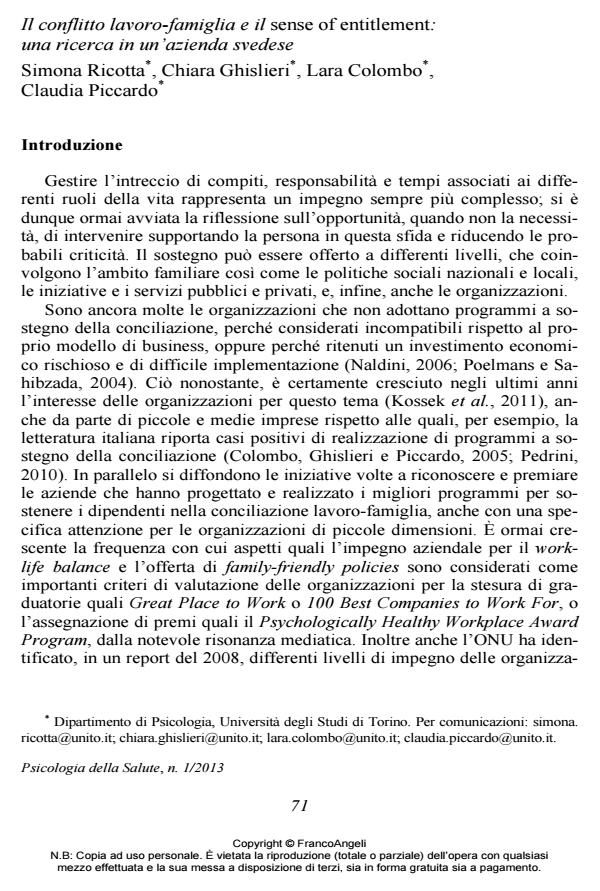Il conflitto lavoro-famiglia e il sense of entitlement: una ricerca in un’azienda svedese
Titolo Rivista PSICOLOGIA DELLA SALUTE
Autori/Curatori Simona Ricotta, Chiara Ghislieri, Lara Colombo, Claudia Piccardo
Anno di pubblicazione 2013 Fascicolo 2013/1
Lingua Italiano Numero pagine 18 P. 71-88 Dimensione file 408 KB
DOI 10.3280/PDS2013-001004
Il DOI è il codice a barre della proprietà intellettuale: per saperne di più
clicca qui
Qui sotto puoi vedere in anteprima la prima pagina di questo articolo.
Se questo articolo ti interessa, lo puoi acquistare (e scaricare in formato pdf) seguendo le facili indicazioni per acquistare il download credit. Acquista Download Credits per scaricare questo Articolo in formato PDF

FrancoAngeli è membro della Publishers International Linking Association, Inc (PILA)associazione indipendente e non profit per facilitare (attraverso i servizi tecnologici implementati da CrossRef.org) l’accesso degli studiosi ai contenuti digitali nelle pubblicazioni professionali e scientifiche
Il conflitto lavoro-famiglia, dovuto all’incompatibilità tra le richieste associate al ruolo lavorativo e a quello familiare, rappresenta un tema oggetto di crescente attenzione per le sue possibili conseguenze negative a livello individuale, familiare e organizzativo. La presente ricerca ha coinvolto 641 dipendenti di un’azienda svedese, con l’obiettivo di valutare l’influenza di alcune variabili (il carico di lavoro e il numero di ore lavorative, la qualità delle relazioni, il supporto organizzativo alla conciliazione) sul conflitto lavoro-famiglia e di osservare eventuali differenze nelle determinanti del conflitto lavoro-famiglia in relazione alla percezione di legittimità del supporto organizzativo (sense of entitlement). Le risposte evidenziano la presenza di un elevato sense of entitlement e mostrano che il conflitto lavorofamiglia aumenta al crescere del carico di lavoro e diminuisce in presenza di buone relazioni con il management e di supporto organizzativo. Quest’ultimo aspetto, però, riduce la percezione di conflitto solo per coloro con alto sense of entitlement.
Parole chiave:Conflitto lavoro-famiglia; sense of entitlement; supporto organizzativo.
- Il benessere nei vigili del fuoco volontari: la mindfulness come risorsa psicologica Piergiorgio Argentero, Ilaria Setti, in PSICOLOGIA DELLA SALUTE 2/2015 pp.101
DOI: 10.3280/PDS2015-002006
Simona Ricotta, Chiara Ghislieri, Lara Colombo, Claudia Piccardo, Il conflitto lavoro-famiglia e il sense of entitlement: una ricerca in un’azienda svedese in "PSICOLOGIA DELLA SALUTE" 1/2013, pp 71-88, DOI: 10.3280/PDS2013-001004